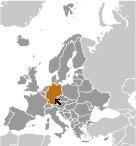World Atlas: Germany. On this page you can see the map, country flag and many detailed information about the people, history and economy of Germany.

Here you can find online selected information about the geography, inhabitants, government, economy and history of Germany. Included are selected statistics, an overview map and the detailed map of Germany. But let's start with the flag of Germany here:
Germany - Overview:
What you should know about Germany? Let's start with this: As Europe's largest economy and second most populous nation (after Russia), Germany is a key member of the continent's economic, political, and defense organizations. European power struggles immersed Germany in two devastating World Wars in the first half of the 20th century and left the country occupied by the victorious Allied powers of the US, UK, France, and the Soviet Union in 1945. With the advent of the Cold War, two German states were formed in 1949: the western Federal Republic of Germany (FRG) and the eastern German Democratic Republic (GDR). The democratic FRG embedded itself in key western economic and security organizations, the EC, which became the EU, and NATO, while the communist GDR was on the front line of the Soviet-led Warsaw Pact. The decline of the USSR and the end of the Cold War allowed for German reunification in 1990. Since then, Germany has expended considerable funds to bring eastern productivity and wages up to western standards. In January 1999, Germany and 10 other EU countries introduced a common European exchange currency, the euro.
Geography of Germany
 Where on the globe is Germany? The location of this country is Central Europe, bordering the Baltic Sea and the North Sea, between the Netherlands and Poland, south of Denmark. Total area of Germany is 357,022 sq km, of which 348,672 sq km is land. So this is quite a large country. How could we describe the terrain of the country? This way: lowlands in north, uplands in center, Bavarian Alps in south. The lowest point of Germany is Neuendorf bei Wilster -3.5 m, the highest point Zugspitze 2,963 m. And the climate is temperate and marine; cool, cloudy, wet winters and summers; occasional warm mountain (foehn) wind.
Where on the globe is Germany? The location of this country is Central Europe, bordering the Baltic Sea and the North Sea, between the Netherlands and Poland, south of Denmark. Total area of Germany is 357,022 sq km, of which 348,672 sq km is land. So this is quite a large country. How could we describe the terrain of the country? This way: lowlands in north, uplands in center, Bavarian Alps in south. The lowest point of Germany is Neuendorf bei Wilster -3.5 m, the highest point Zugspitze 2,963 m. And the climate is temperate and marine; cool, cloudy, wet winters and summers; occasional warm mountain (foehn) wind.
Inhabitants of Germany
Let's take a look how many people live in Germany. The number is: 80,594,017 (July 2017 est.). So this country is among the most populous in the World. Who lives here? German 91.5%, Turkish 2.4%, other 6.1% (made up largely of Polish, Italian, Romanian, Syrian, and Greek). What are the languages in Germany? German (official). And the religions: Roman Catholic 29%, Protestant 27%, Muslim 4.4%, Orthodox Christian 1.9%, other 1.7%, none or members of unrecorded religious groups 36% (2015 est.). How old are the people in average? 47.1 years. We have to add that this number is the median - so one half of the people is older than this, one half is younger. And what is their life expectancy (at birth)? This: 80.8 years. Where the people live in Germany? Here: most populous country in Europe; a fairly even distribution throughout most of the country, with urban areas attracting larger and denser populations, particularly in the far western part of the industrial state of North Rhine-Westphalia. The major urban areas of Germany are: Berlin (capital) 3.563 million; Hamburg 1.831 million; Munich 1.438 million; Cologne 1.037 million (2015).
Government and Economy of Germany
The capital of Germany is Berlin and the government type federal parliamentary republic. Let's take a look at the administrative divisions - 16 states (Laender, singular - Land); Baden-Wuerttemberg, Bayern (Bavaria), Berlin, Brandenburg, Bremen, Hamburg, Hessen (Hesse), Mecklenburg-Vorpommern (Mecklenburg-Western Pomerania), Niedersachsen (Lower Saxony), Nordrhein-Westfalen (North Rhine-Westphalia), Rheinland-Pfalz (Rhineland-Palatinate), Saarland, Sachsen (Saxony), Sachsen-Anhalt (Saxony-Anhalt), Schleswig-Holstein, Thueringen (Thuringia); note - Bayern, Sachsen, and Thueringen refer to themselves as free states (Freistaaten, singular - Freistaat), while Hamburg prides itself on being a Free and Hanseatic City (Freie und Hansestadt). Regarding the economy of Germany, important industrial products are among the world's largest and most technologically advanced producers of iron, steel, coal, cement, chemicals, machinery, vehicles, machine tools, electronics, automobiles, food and beverages, shipbuilding, textiles. Important agricultural products are potatoes, wheat, barley, sugar beets, fruit, cabbages; milk products; cattle, pigs, poultry. The most important export commodities are motor vehicles, machinery, chemicals, computer and electronic products, electrical equipment, pharmaceuticals, metals, transport equipment, foodstuffs, textiles, rubber and plastic products and the most important export partners are US 8.9%, France 8.4%, UK 7.1%, Netherlands 6.5%, China 6.4%, Italy 5.1%, Austria 5%, Poland 4.5%, Switzerland 4.2% (2016). The most important import commodities are machinery, data processing equipment, vehicles, chemicals, oil and gas, metals, electric equipment, pharmaceuticals, foodstuffs, agricultural products and the most important import partners are Netherlands 13.3%, China 7.3%, France 7.3%, Belgium 6.1%, Italy 5.5%, Poland 5.2%, Czech Republic 4.7%, US 4.6%, Switzerland 4.4%, Austria 4.4%, UK 4.1% (2016). How rich is Germany and how rich are people in this country? The most important number here is GDP per capita (PPP): $50,200 (2017 est.). This means the people are rich on average here. Let's add that this means Gross Domestic Product per person, which is recalculated with respect to the relative cost of local goods and services. And one more important number - population below poverty line: 16.7% (2015 est.).